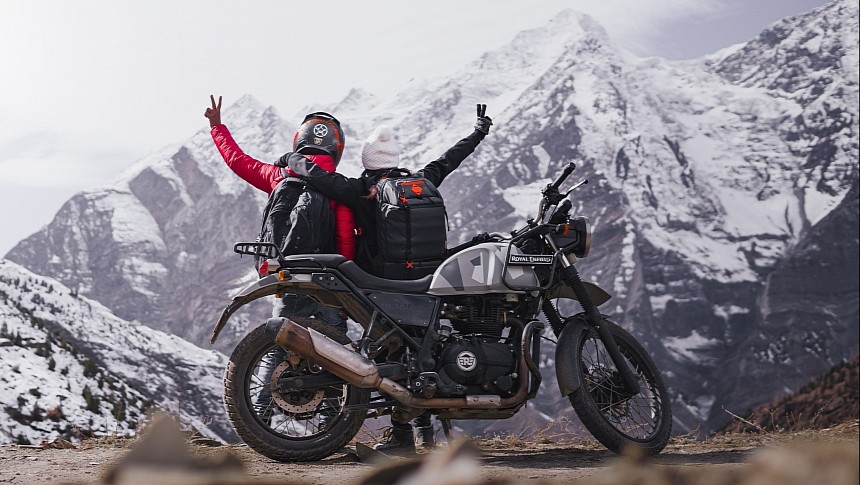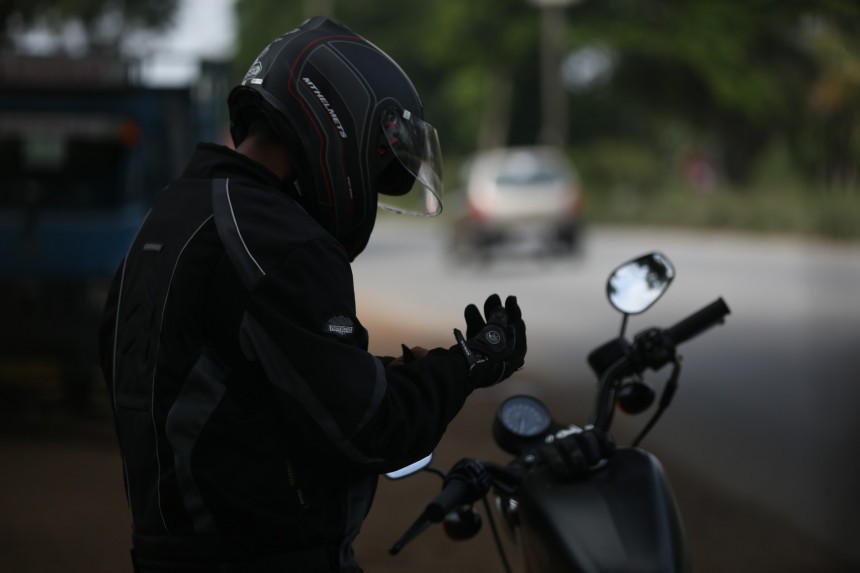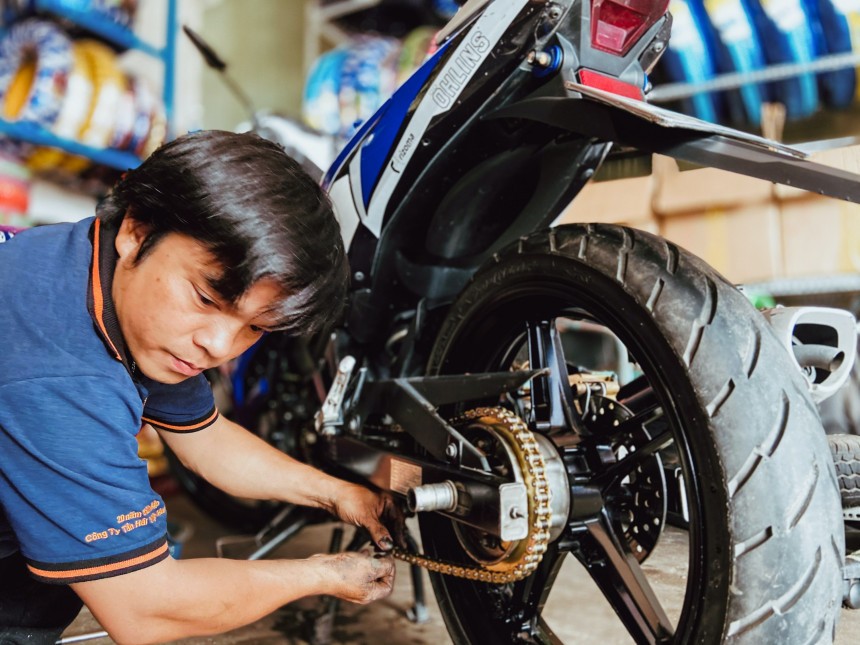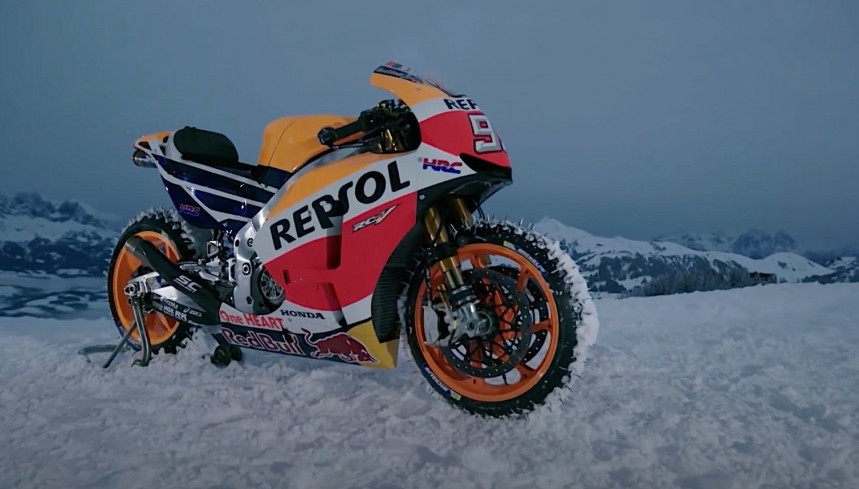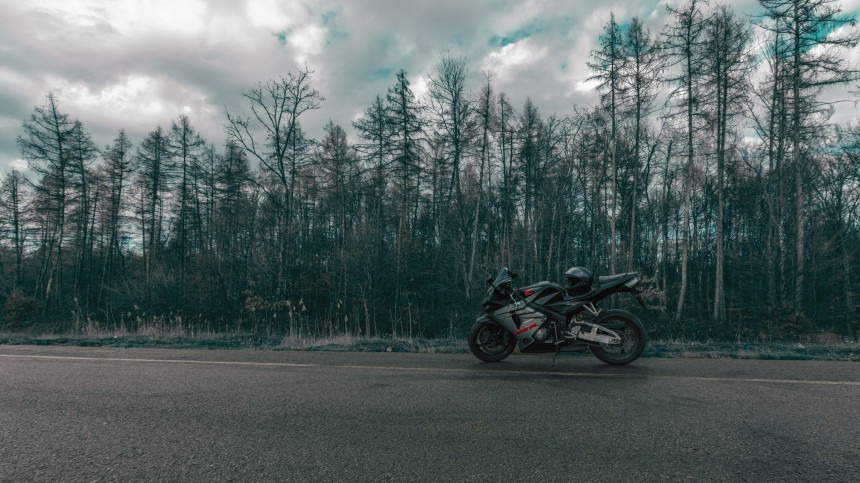Most motorcycle riders store their motorcycles for winter time. Of course, it all depends on where you're from, but in most places across the globe, you'll see fewer and fewer motorcycles on the road as winter approaches. This article is dedicated to the brave souls out there who have decided winter and all the conditions that ensue won't stop them from riding their two-wheelers.
Before we go into detail, I feel like offering a fair warning on why riding your motorcycle during the winter might be a bad idea, especially if you're not an experienced rider.
Besides the cold, the most obvious issue when riding during the winter is snow. As I mentioned, it depends on where you're riding, as some places don't experience snowfall at all. But, in those that do, riding becomes way more dangerous, as motorcycles will struggle to get grip. You can prepare for that; I'll talk about it shortly.
If these things don't scare you, you can consider riding your motorbike during winter. That's more important than people think: being confident in handling these rough conditions. So, if you're not ready to part ways with your two-wheeler for the winter, let's see how you can prepare.
The cold air, snow, ice, and other winter conditions will significantly affect your bike and your body. That's why ensuring your riding gear protects you is critical, with insulation being the most important part.
The easiest and most effective way to keep warm while riding in cold conditions is by layering. The more layers you have on, the better. Of course, you can't simply throw on whatever you find in your closet – besides insulation, you must use gear that provides adequate protection.
So, what's the science behind layering? It's not that complicated – the more layers you wear, the more warm air you'll trap between the layers, so the warmer you'll be. Multiple thin layers of clothing will always be a better choice than using fewer bulkier ones.
You must choose the correct type of layers because you don't want moisture and sweat to be trapped under your gear. Another benefit of using multiple layers is that you can simply remove one if you need to regulate your temperature.
It all depends on the exact conditions you'll be riding in. That being said, there's a formula to layering that will work wherever you're riding. I'll keep it as short and sweet as possible.
The first layer you'll need is the base layer, which essentially acts as your second skin. Its purpose is to trap warmth while drawing off the sweat and moisture to your second layer. A safe choice is a natural fiber, such as merino wool, although synthetic ones like polyester and nylon will also do the job. This base layer should fit snugly to prevent warm air from escaping.
Next, we have the mid-layer – its role is to insulate the body by keeping the warmth in. This layer can have two parts if you're traveling in freezing conditions. In this case, you should the first one should be warm and thin. The second one can be a thicker thermal fleece, a down jacket, or even an electric heated jacket. If it's not that cold, you can opt for a single layer and use a fleece or a down jacket.
And lastly, we have the outer shell layer, the one that will face the cold. It must be a motorcycle jacket with integrated protection that will also keep you warm. It's essential for it to be fully waterproof, so you should purchase a piece of gear dedicated to riding in the cold.
Gore-Tex is one of the names most often thrown around when discussing cold-weather clothing. Long story short, it's a waterproof and breathable fabric – what makes it so good is that it can repel water while allowing vapor to pass through. Of course, this is a brand, and there are many other alternatives out there. However, you can expect excellent quality when purchasing any piece of clothing with Gore-Tex.
The next level would be Pro-Laminate Gore-Tex, more simply known as Laminate. What makes this different from the Gore-Tex lining, which is typically removable, is that this membrane is built into the piece of equipment. Again, Gore-tex is one of many brands that produce laminated fabric.
Of course, dressing properly refers to more than just your torso area. You should follow the same dressing format when it comes to trousers, although you could skip the mid-layer, depending on the conditions.
Regarding boots, the best choice is adventure-style bike boots. They're large and tall, offer excellent protection, come with extra padding, and will keep cold and water away from your feet.
When choosing boots, make sure they fit correctly, meaning you don't need them to be very tight. That allows space for a thick pair of socks.
Another body extremity that requires special protection is your hands. You don't want to ride in the cold and realize at some point that your hand is numb, eventually leading to frostbite, with the risk of losing your fingers.
An excellent option is Gore-Tex gloves, as they provide fantastic insulation. The glove's gauntlet should be easy to tighten and should slide underneath your sleeve. Other options include lobster gloves, which retain more heat by keeping your fingers grouper, or heated gloves.
A winter-ready motorcycle helmet is also a must. Typically, the best and warmest option you could go for is a touring helmet, which can also come with a neck curtain and a chin guard.
Another thing you should look for is a pin-lock insert, which will prevent your visor from misting up. Moreover, consider a wool, silk, or synthetic balaclava for additional protection.
So, you've purchased all the necessary gear for riding. Before you go out, you need to make sure your motorcycle is just as ready as you are. Most bikes are set up for three-season riding, so they're equipped to handle warmer weather.
You need to check a few things before and after a cold-weather ride. First, we have the battery – cold temperatures make it harder to start the bike, and batteries don't work as well in the cold. So, make sure the battery functions correctly. For extra safety, you can carry a battery jump starter onboard.
Next, you must maintain correct fluid levels, such as that of the coolant. However, before that, make sure the fluid you're using is adequate for the temperatures you'll be riding in. What's more, check if you'll need thinner engine oil, as oil becomes thicker when temperatures are low.
Check the wear of your chain and see if it's clean and adequately lubricated. That's especially important because the salt used to clear icy roads can damage your chain in the long run.
And lastly, we have the tires. It's essential you check the tread wear, if they are worn out, and whether you have the correct tire pressure. Moreover, consider buying some winter tires, although they're typically not that easy to find. If that's not possible, at least ensure the rubber you have has a tread pattern suitable for rain and slippery surfaces.
There are countless modifications you can make to your bike. Here are some of the accessories you can equip that will make winter riding safer and more enjoyable. First, a larger windscreen will help deflect the air off your body, thus helping you stay warm. The same goes for lowered fairing, as they will further protect your body. Furthermore, heated seats are another option you could go for.
Even with proper gloves, having other accessories that help keep your hands warm doesn't hurt. Taking inspiration from dirtbike riders, you can fit a set of quality handguards to block the wind. Moreover, you can go even further and install handlebar covers, which provide an additional insulated layer. And lastly, a heated handgrip system is simple and inexpensive to fit.
If you really want to ride in more extreme conditions, the safest bet would be to get your hands on snow-studded tires or even build them yourself if you have the skills. These tires improve control and traction in icy conditions because the metal studs or spikes are embedded into the tire's tread, thus penetrating the ice when riding.
The major downside with snow-studded tires is that they're illegal to use on public roads in some places across the globe because they can damage the road. In the US, most states have seasonal restrictions, while some hotter ones fully prohibit them, and others allow unrestricted use.
First, you must learn to spot the warning signs of cold-induced fatigue. Some of the beginning warning signs include decreased mental clarity, which is more dangerous than any other physical effect.
Hypothermia sets in gradually, and it will take a toll on your most vital organ: the brain. Your active scanning of the road ahead and your surroundings decreases, as well as the anticipation of potential threats. Moreover, you'll have slowed reaction times.
Another symptom you may experience is difficulty taking deep breaths. What's more, your hands and legs become stiff and lose mobility, and you might shiver. You must know when to stop – so when these things happen, it's essential to take a break, heat up, and have a snack.
Even if your tires are in perfect condition and inflated just right, you still need to hit the road cautiously and take your time to warm them up. The best way is to accelerate and decelerate quickly. Of course, do this while being aware of traction and the conditions – you wouldn't want to do either when encountering patches of ice.
Salt is not only damaging to metal, but it can significantly impact traction. So, you should treat it like ice – if you notice crystalized appearances on the side of the road, avoid them. White ice is easier to spot, but black ice blends in with the asphalt, making it way more dangerous. If anything remotely resembles ice, stay away.
Although plow trucks help make the road ridable, they can also damage them by causing cracks. When riding with the correct tire pressure, tiny cracks won't do any harm in most cases. But if you encounter a larger one, you might lose traction.
Another critical tip is to increase your visibility and space when riding in the winter. Look further down the road to identify possible threats and open up your following distance – keep at least a few car lengths of space between you and the next road user.
Get familiar with techniques for snow and ice riding, which can be pretty similar to dirt riding techniques. If you find yourself in the worst-case scenario, it's good to be prepared. However, the safest option would be to realize when you're out of your depth and ride calmly to the nearest place where you can rest, take a breather, and wait for the conditions to improve.
If you're riding and snow starts falling, the best thing to do would be to go home. To prevent this, you should keep an eye on the forecast before heading out.
Regardless of how much and how well you prepare, unfortunately, accidents happen. Make sure you have a towing service in mind that's readily available, especially if you plan on riding for longer distances.
Riding in the winter is very challenging, but it can be a fulfilling experience if done right. These tips will help you stack more miles during colder months and improve your riding skills. As with most things in life, you need lots of practice – take it step by step, don't push yourself too much, and don't take any unnecessary risks.
Why shouldn't you ride in the winter?
Unlike cars, motorcycles don't offer a safe enclosed space. Of course, that's part of the thrill of riding, but when you do it in the cold season, you'll quickly feel the effects. But how cold is too cold? Well, that's up to each rider, and it's significantly influenced by other weather factors, such as wind. If we were to give an exact number, it's not recommended to ride a bike when the temperature drops to 32 degrees Fahrenheit (0 degrees Celsius).Besides the cold, the most obvious issue when riding during the winter is snow. As I mentioned, it depends on where you're riding, as some places don't experience snowfall at all. But, in those that do, riding becomes way more dangerous, as motorcycles will struggle to get grip. You can prepare for that; I'll talk about it shortly.
If these things don't scare you, you can consider riding your motorbike during winter. That's more important than people think: being confident in handling these rough conditions. So, if you're not ready to part ways with your two-wheeler for the winter, let's see how you can prepare.
Dressing for the ride
The easiest and most effective way to keep warm while riding in cold conditions is by layering. The more layers you have on, the better. Of course, you can't simply throw on whatever you find in your closet – besides insulation, you must use gear that provides adequate protection.
So, what's the science behind layering? It's not that complicated – the more layers you wear, the more warm air you'll trap between the layers, so the warmer you'll be. Multiple thin layers of clothing will always be a better choice than using fewer bulkier ones.
You must choose the correct type of layers because you don't want moisture and sweat to be trapped under your gear. Another benefit of using multiple layers is that you can simply remove one if you need to regulate your temperature.
It all depends on the exact conditions you'll be riding in. That being said, there's a formula to layering that will work wherever you're riding. I'll keep it as short and sweet as possible.
The first layer you'll need is the base layer, which essentially acts as your second skin. Its purpose is to trap warmth while drawing off the sweat and moisture to your second layer. A safe choice is a natural fiber, such as merino wool, although synthetic ones like polyester and nylon will also do the job. This base layer should fit snugly to prevent warm air from escaping.
Next, we have the mid-layer – its role is to insulate the body by keeping the warmth in. This layer can have two parts if you're traveling in freezing conditions. In this case, you should the first one should be warm and thin. The second one can be a thicker thermal fleece, a down jacket, or even an electric heated jacket. If it's not that cold, you can opt for a single layer and use a fleece or a down jacket.
And lastly, we have the outer shell layer, the one that will face the cold. It must be a motorcycle jacket with integrated protection that will also keep you warm. It's essential for it to be fully waterproof, so you should purchase a piece of gear dedicated to riding in the cold.
Gore-Tex is one of the names most often thrown around when discussing cold-weather clothing. Long story short, it's a waterproof and breathable fabric – what makes it so good is that it can repel water while allowing vapor to pass through. Of course, this is a brand, and there are many other alternatives out there. However, you can expect excellent quality when purchasing any piece of clothing with Gore-Tex.
The next level would be Pro-Laminate Gore-Tex, more simply known as Laminate. What makes this different from the Gore-Tex lining, which is typically removable, is that this membrane is built into the piece of equipment. Again, Gore-tex is one of many brands that produce laminated fabric.
Of course, dressing properly refers to more than just your torso area. You should follow the same dressing format when it comes to trousers, although you could skip the mid-layer, depending on the conditions.
Regarding boots, the best choice is adventure-style bike boots. They're large and tall, offer excellent protection, come with extra padding, and will keep cold and water away from your feet.
When choosing boots, make sure they fit correctly, meaning you don't need them to be very tight. That allows space for a thick pair of socks.
Another body extremity that requires special protection is your hands. You don't want to ride in the cold and realize at some point that your hand is numb, eventually leading to frostbite, with the risk of losing your fingers.
An excellent option is Gore-Tex gloves, as they provide fantastic insulation. The glove's gauntlet should be easy to tighten and should slide underneath your sleeve. Other options include lobster gloves, which retain more heat by keeping your fingers grouper, or heated gloves.
A winter-ready motorcycle helmet is also a must. Typically, the best and warmest option you could go for is a touring helmet, which can also come with a neck curtain and a chin guard.
Another thing you should look for is a pin-lock insert, which will prevent your visor from misting up. Moreover, consider a wool, silk, or synthetic balaclava for additional protection.
Motorcycle Maintenance
You need to check a few things before and after a cold-weather ride. First, we have the battery – cold temperatures make it harder to start the bike, and batteries don't work as well in the cold. So, make sure the battery functions correctly. For extra safety, you can carry a battery jump starter onboard.
Next, you must maintain correct fluid levels, such as that of the coolant. However, before that, make sure the fluid you're using is adequate for the temperatures you'll be riding in. What's more, check if you'll need thinner engine oil, as oil becomes thicker when temperatures are low.
Check the wear of your chain and see if it's clean and adequately lubricated. That's especially important because the salt used to clear icy roads can damage your chain in the long run.
And lastly, we have the tires. It's essential you check the tread wear, if they are worn out, and whether you have the correct tire pressure. Moreover, consider buying some winter tires, although they're typically not that easy to find. If that's not possible, at least ensure the rubber you have has a tread pattern suitable for rain and slippery surfaces.
Motorcycle Modifications
There are countless modifications you can make to your bike. Here are some of the accessories you can equip that will make winter riding safer and more enjoyable. First, a larger windscreen will help deflect the air off your body, thus helping you stay warm. The same goes for lowered fairing, as they will further protect your body. Furthermore, heated seats are another option you could go for.
Even with proper gloves, having other accessories that help keep your hands warm doesn't hurt. Taking inspiration from dirtbike riders, you can fit a set of quality handguards to block the wind. Moreover, you can go even further and install handlebar covers, which provide an additional insulated layer. And lastly, a heated handgrip system is simple and inexpensive to fit.
If you really want to ride in more extreme conditions, the safest bet would be to get your hands on snow-studded tires or even build them yourself if you have the skills. These tires improve control and traction in icy conditions because the metal studs or spikes are embedded into the tire's tread, thus penetrating the ice when riding.
The major downside with snow-studded tires is that they're illegal to use on public roads in some places across the globe because they can damage the road. In the US, most states have seasonal restrictions, while some hotter ones fully prohibit them, and others allow unrestricted use.
Riding Tips
Presuming you've ticked all the boxes above, both you and your motorbike are locked and loaded for a winter ride. Now, it's all about how you handle the two-wheeler in the winter conditions. Here are some tips and tricks that will help you keep the bike upright and remain safe.First, you must learn to spot the warning signs of cold-induced fatigue. Some of the beginning warning signs include decreased mental clarity, which is more dangerous than any other physical effect.
Hypothermia sets in gradually, and it will take a toll on your most vital organ: the brain. Your active scanning of the road ahead and your surroundings decreases, as well as the anticipation of potential threats. Moreover, you'll have slowed reaction times.
Another symptom you may experience is difficulty taking deep breaths. What's more, your hands and legs become stiff and lose mobility, and you might shiver. You must know when to stop – so when these things happen, it's essential to take a break, heat up, and have a snack.
Even if your tires are in perfect condition and inflated just right, you still need to hit the road cautiously and take your time to warm them up. The best way is to accelerate and decelerate quickly. Of course, do this while being aware of traction and the conditions – you wouldn't want to do either when encountering patches of ice.
Although plow trucks help make the road ridable, they can also damage them by causing cracks. When riding with the correct tire pressure, tiny cracks won't do any harm in most cases. But if you encounter a larger one, you might lose traction.
Another critical tip is to increase your visibility and space when riding in the winter. Look further down the road to identify possible threats and open up your following distance – keep at least a few car lengths of space between you and the next road user.
Get familiar with techniques for snow and ice riding, which can be pretty similar to dirt riding techniques. If you find yourself in the worst-case scenario, it's good to be prepared. However, the safest option would be to realize when you're out of your depth and ride calmly to the nearest place where you can rest, take a breather, and wait for the conditions to improve.
If you're riding and snow starts falling, the best thing to do would be to go home. To prevent this, you should keep an eye on the forecast before heading out.
Regardless of how much and how well you prepare, unfortunately, accidents happen. Make sure you have a towing service in mind that's readily available, especially if you plan on riding for longer distances.
Riding in the winter is very challenging, but it can be a fulfilling experience if done right. These tips will help you stack more miles during colder months and improve your riding skills. As with most things in life, you need lots of practice – take it step by step, don't push yourself too much, and don't take any unnecessary risks.
